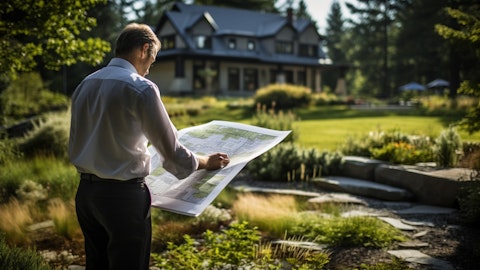But do you see yourselves becoming more aggressive or maybe accelerating some of the conversations you were having with potential clients in Germany? And whether or not that — or if you could maybe provide color on whether or not that would play into revenues maybe in the back half of ’24?
Brad Nattrass: The issue with Germany is it’s going to be social licenses, so sort of like Maine in the US, social clubs where people can grow their own cannabis. And so it’s going to take a while for that market to build out and to develop. So I don’t see a lot of near term opportunity. There’s three existing operators in the country now. I think they will be the first probably to grow into it, so we’ll watch them closely. In Europe, overall, when we entered and built our entity up two years ago, we had a signed contract to build out 20 vertical farms in urban centers, like in food service distribution centers or near hotel groups, for example. And then we built out that team and sure enough about a month later, the war in Eastern Europe broke out.
And that just wreaked havoc on the horticulture marketplace, energy prices skyrocketed. And manufacturers in Europe and all of the ancillary companies and that horticulture industry really suffered for a couple of years. So we fortunately had green sprouts in the cannabis space, right? So we designed in Israel and Switzerland, Portugal. We’re actively working on projects right now in the Netherlands. Portugal, I think, will be a strong year. But we just couldn’t wait around anymore. We had burnt considerable funds over there. And we have to be — we have to show that we can run a profitable company. And that is absolutely what we’re going to do. And so the managing director is a phenomenal individual who is a great leader, but the business wasn’t there.
So we released the managing director and a couple of others. But we’ve kept some key experts that deliver the design, horticulturists that have experience in hundreds of facilities over here, because I do believe we want to align into Europe. There’s not a lot of Curaleaf, the most outspoken group, of course, that is aggressively growing on an international spread. We want to be there. There’s going to be facilities built and we have that expertise. So we’re just slowing it down a little bit and keeping our lines of communication with multiple groups open. Similar to the US, it’s the same story, it’s all about capital and being able to raise their funds. So we have some strong — you asked earlier about the pipeline. We’ve got some strong design builds in our pipeline for Europe as well, but they won’t materialize until they can access those funds.
Operator: Up next is Eric Beder with SCC Research.
Eric Beder: Most of my questions have already been answered, but I want to talk about some other things here. On the commercial space, what — when you look at the why people are hiring you and what is the niche, what is the pitch to the commercial client for your business, and how are you winning these businesses forward?
Brad Nattrass: So there’s a lot of design build firms that operate on $0.5 billion, $1 billion plus or infrastructure, jobs around the world like the AECOM or Stantec, large companies like that. Jacob Solutions, among others. We had — the niche for us is the all under one roof, one single point of responsibility on projects, we say under $50 million, the largest so far for us is around $30 million. But clients have, not in the commercial space, been able to access all one single point of responsibility in the space. They’ve had to hire their own project managers and go to an architect and find an engineer, then hire those GCs themselves, then procure the equipment either directly or through the contractors. We’ve realized that having it all provides a big service that allows us to complete their facility quicker than they would have before.
And for the large Fortune 50 clients that we have right now, we’re able to really turn projects quickly and we can do a good job at it and we can make money out of it. It’s the larger $1 billion type project companies, they don’t want to operate at these smaller levels. So right now, it’s a perfect size for us. In the future, as we continue expansion, we would look at increasing the size. But right now, we’ve got a great niche and it’s working.
Eric Beder: And the equipment business has been tough for a number of years now. So what are you seeing on the other side of that when you go to buy from these equipment manufacturers, are they more to give you a deal, a better deal? Are there less equipment players out there? How should we be thinking about that in terms of potential when that potentially comes back to be able to generate margins that used to be or even better?
Brad Nattrass: So on the controlled environment ag side for cannabis and horticulture, it’s been tough for manufacturers over the last two years. A lot of large reductions of force, some are no longer in operation. So I feel that we have the ability now to have some really strong strategic partnerships with these manufacturers. They don’t have to go out and hire or build out their sales team when they’re just selling one product line. And with us, with good strong relationships to the end client and we’ve had a chance to build that relationship and trust early from working from the design stages forward, we’re able to take them in and therefore, it can be an easier path to success for them. Moreover, from purchasing to our standpoint, if we’re purchasing and procuring for a lot of facilities, that gives us a nice advantage.


